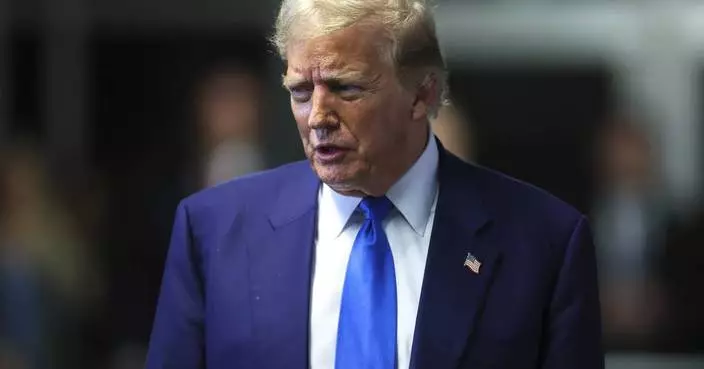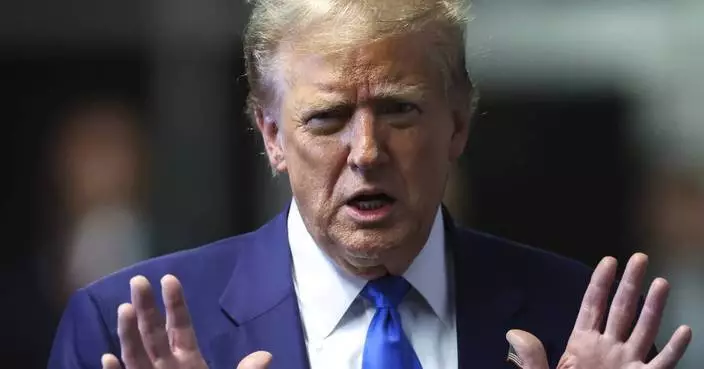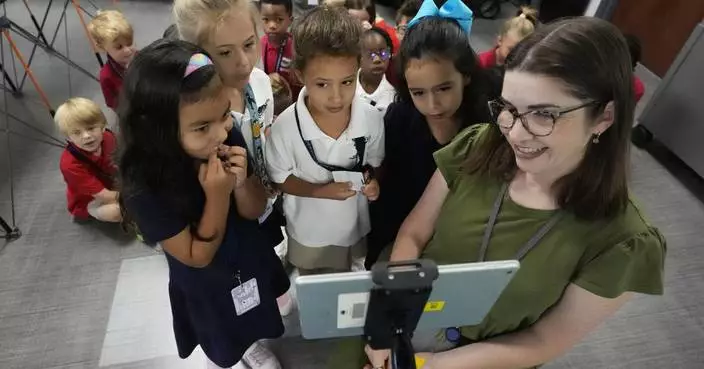Trump administration officials said Monday they're crafting a new legislative package aimed at closing immigration "loopholes," hours after the president called on Republicans in Congress to immediately pass a border bill using the "Nuclear Option if necessary" to muscle it through.
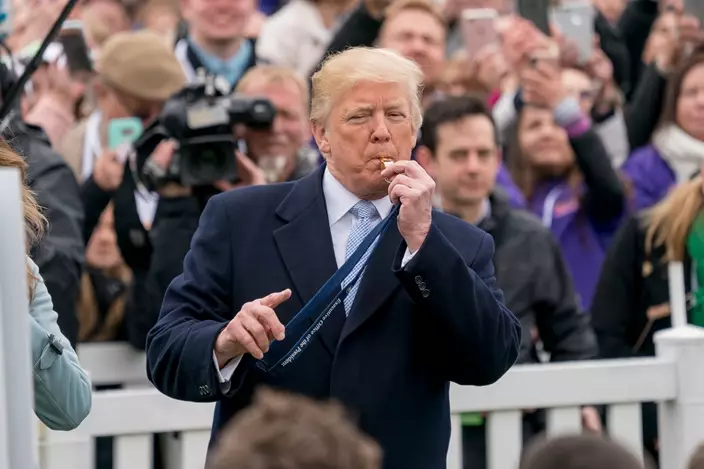
President Donald Trump blows a whistle to start a race for the annual White House Easter Egg Roll on the South Lawn of the White House in Washington, Monday, April 2, 2018. (AP Photo/Andrew Harnik)
"Border Patrol Agents (and ICE) are GREAT, but the weak Dem laws don't allow them to do their job. Act now Congress, our country is being stolen!" President Donald Trump wrote in a series of sometimes-misleading tweets, fired off after returning from a holiday weekend spent in Florida with several immigration hardliners.
Trump also declared protections for so-called Dreamer immigrants "dead," claimed the U.S. has "no effective border laws" and warned Mexico to halt the passage of "caravans" of illegal immigrants or risk retribution.
"They must stop the big drug and people flows, or I will stop their cash cow, NAFTA. NEED WALL!" he wrote.
Trump has been seething over immigration since realizing the major spending bill he signed last month barely funds the "big, beautiful" border wall he has promised his supporters. The $1.3 trillion funding package included $1.6 billion in border wall spending, but much of that money can be used only to repair existing segments, not to build new sections.
Among the measures the administration is pursuing: ending special safeguards that prevent the immediate deportation of children arrested at the border and traveling alone. Under current law, unaccompanied children from countries that don't border the U.S. would be placed under the supervision of the Department of Health and Human Services and undergo often-lengthy deportation proceedings before an immigration judge instead of being deported.
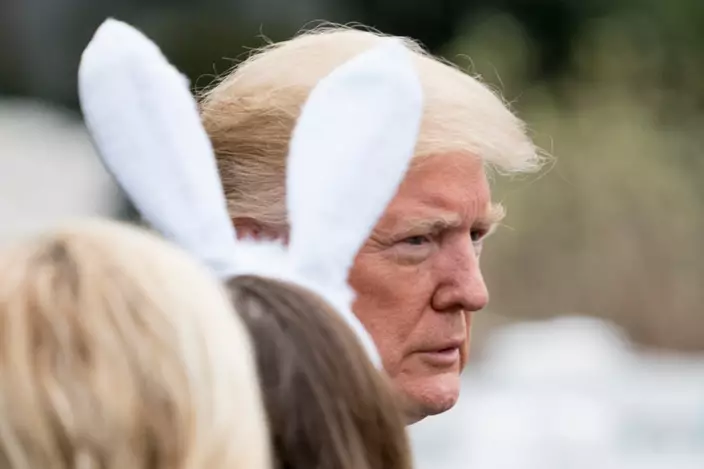
President Donald Trump arrives for the annual White House Easter Egg Roll on the South Lawn of the White House in Washington, Monday, April 2, 2018. (AP Photo/Andrew Harnik)
The administration is also pushing Congress to terminate a 1997 court settlement that requires the government to release children from custody to parents, adult relatives or other caretakers as their cases make their way through immigration court. Officials complain that many children never show up at their hearings.
The proposals appear the same as those included on a White House immigration wish list that was released in October but failed to gain traction during negotiations over the border wall. Such proposals are likely to face opposition from moderate Republicans and Democrats going into the midterm elections. But Trump appears intent on ensuring the issues remain at the forefront of public conversation, even though the omnibus was widely seen as the last major legislation likely passed this year.
In his Easter weekend tweets and comments, Trump continued to blame Democrats for killing the Obama-era Deferred Action for Childhood Arrivals program despite the fact that he was the one who moved to end the program. He also claimed DACA, which has provided temporary protection from deportation and work permits to hundreds of thousands of young people, is luring people to cross the border illegally, even though the program — and most proposals to replace it — have never been open to new arrivals.
Trump spent much of the weekend at his Mar-a-Lago club, having meals with his family, watching cable news shows and rubbing elbows with conservative commentators including Fox News host Sean Hannity, according to several club members. Also spotted at the club: championship golfer Dustin Johnson, MyPillow maker Michael J. Lindell, boxing promoter Don King and former New York Police Commissioner Bernie Kerik.
Staffers with Trump over the holiday included policy adviser Stephen Miller, one of the chief architects of the administration's anti-immigration policies, but not his chief of staff John Kelly or his elder daughter, Ivanka, both considered more moderate influences.
Trump's past calls to use the "nuclear option" — changing the Senate rules to require a simple majority of 51 votes to override a rule instead of 60— have been repeatedly dismissed by Senate Majority Leader Mitch McConnell, who argues Republicans will welcome the filibuster if they return to being the Senate minority. The current split is 51-49 favoring Republicans.
Notably, Trump's favored DACA solution mustered only 39 votes in the Senate, meaning it couldn't have passed even if the Senate did approve the changes.
Trump's tweets calling on Mexico to halt "caravans" filled with immigrants in the country illegally came after a "Fox & Friends" report early Sunday that featured the leader of the union representing border patrol agents predicting that those in the caravan would create havoc and chaos in the U.S. as they wait for immigration reform.
About 1,100 migrants, many from Honduras, have been marching along roadsides and train tracks in the southern Mexican state of Oaxaca.
These "Stations of the Cross" migrant caravans have been held in southern Mexico for at least the last five years. They began as short processions of migrants, some dressed in biblical garb and carrying crosses, as an Easter-season protest against the kidnappings, extortion, beatings and killings suffered by many Central American migrants as they cross Mexico.
Individuals in the caravans often try to reach the U.S. border but usually not as part of the caravan. The caravans typically don't proceed much farther north than the Gulf coast state of Veracruz. The current march is scheduled to end this month with a conference on migration issues in the central Mexican state of Puebla.
Russia plans to hold drills simulating the use of battlefield nuclear weapons, the Defense Ministry announced Monday, days after the Kremlin reacted angrily to comments by senior Western officials about the war in Ukraine and Moscow warned that tensions with the West are deepening.
The drills are in response to “provocative statements and threats of certain Western officials regarding the Russian Federation,” the Defense Ministry said in a statement.
It was the first time that Russia has publicly announced drills involving tactical nuclear weapons, though its strategic nuclear forces regularly hold exercises. Tactical nuclear weapons include air bombs, warheads for short-range missiles and artillery munitions and are meant for use on a battlefield. They are less powerful than the massive warheads that arm intercontinental ballistic missiles and are intended to obliterate entire cities.
The Russian announcement appeared to be a warning to Ukraine’s Western allies about becoming more deeply involved in the more than two-year war. Some of Ukraine’s Western partners have previously expressed concern about stoking the conflict amid fears it could spill beyond Ukraine into a war between NATO and Russia.
French President Emmanuel Macron repeated last week that he doesn’t exclude sending troops to Ukraine, and U.K. Foreign Secretary David Cameron said Kyiv’s forces will be able to use British long-range weapons to strike targets inside Russia. Some other NATO countries providing weapons to Kyiv have balked at that possibility.
The Kremlin branded those comments as dangerous, heightening tension between Russia and NATO. The war already has placed significant strain on relations between Moscow and the West.
Kremlin spokesman Dmitry Peskov on Monday said Macron’s recent statement and other remarks by British and U.S. officials had prompted the nuclear drills.
“It’s a new round of escalation,” Peskov said, referring to what the Kremlin regarded as provocative statements. “It’s unprecedented and requires special attention and special measures,” Peskov told reporters.
Dmitry Medvedev, the deputy head of Russia’s Security Council that's chaired by President Vladimir Putin, said in his typically hawkish fashion that the comments by Macron and Cameron risked pushing the nuclear-armed world toward a “global catastrophe.”
It wasn’t the first time Europe’s military support for Ukraine has irked Russian authorities and prompted nuclear saber-rattling. In March last year, after the U.K. government’s decision to provide Ukraine with armor-piercing shells containing depleted uranium, Putin announced that he intends to deploy tactical nuclear weapons on the territory of Belarus.
The ministry said the exercise is intended to “increase the readiness of non-strategic nuclear forces to fulfill combat tasks” and will be held on Putin’s orders. The maneuvers will involve missile units of the Southern Military District along with the air force and the navy, it said.
Western officials have blamed Russia for threatening a wider war through provocative acts. NATO countries said last week they are deeply concerned by a campaign of hybrid activities on the military alliance’s soil, accusing Russia of being behind them and saying they represent a threat to their security.
Peskov dismissed those claims as “new unfounded accusations leveled at our country.”
Meanwhile, Ukrainian drones hit two vehicles Monday in Russia’s Belgorod region, killing six people and injuring 35 others, including two children, local authorities said, in an area frequently struck by Kyiv’s forces in recent months.
One of the vehicles was a minibus that was carrying farm workers, Belgorod Gov. Vyacheslav Gladkov said.
No other details were immediately available, and it was not possible to independently confirm the report from the border region.
While Ukraine’s army is largely pinned down on the 1,000-kilometer (600-mile) front line due to a shortage of troops and ammunition after more than two years of fighting, it has used its long-range firepower to hit targets deep inside Russia. The apparent aim is to disrupt Russia’s war logistics system by hitting oil refineries and depots, and unnerve the Russian border regions.
The Belgorod region was a staging ground for Russia’s full-scale invasion of Ukraine in February 2022. It has come under regular attack ever since Russian forces retreated there from northeastern Ukraine early in the war following a counteroffensive by Kyiv.
In what has largely been a war of attrition, Russia has also relied heavily on long-range missile, artillery and drones to wreak damage on Ukraine.
At the end of last year, Belgorod officials said 25 people were killed, including five children, and more than 100 were injured in a Ukrainian attack, and regular rocket and drone strikes have continued since then. The area can be reached by relatively simple and mobile weapons such as multiple rocket launchers from forests on the Ukrainian side.
Russian authorities said in March they planned to evacuate about 9,000 children from the area because of continuous shelling, after Putin said he wanted to create a buffer zone to help protect border regions.
Also, the Kremlin's forces kept up their bombardment of Ukraine's power grid, with a nighttime Russian drone attack targeting energy infrastructure in Ukraine’s northern region of Sumy. Multiple towns and villages in the region, including Sumy, lost power, regional authorities said.
Russia attacked Ukrainian targets with 13 Shahed drones overnight, 12 of which were intercepted in the Sumy region, Ukraine’s air force said.
Follow AP’s coverage of the war in Ukraine at https://apnews.com/hub/russia-ukraine
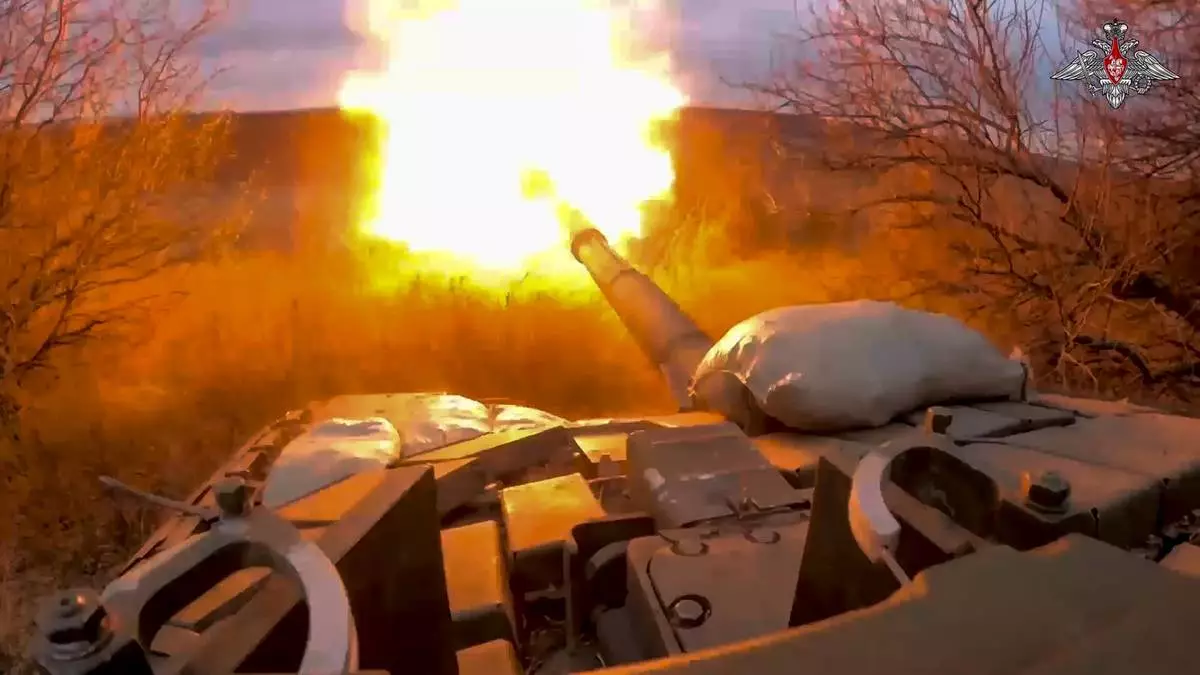
FILE - In this photo released by the Russian Defense Ministry on March 19, 2024, a Russian tank fires at Ukrainian troops from a position near the border with Ukraine in Russia’s Belgorod region. (Russian Defense Ministry Press Service via AP, File)







